 
(inscription on the fortress of Vejano celebrating its reconstruction by the Santacroce)
|
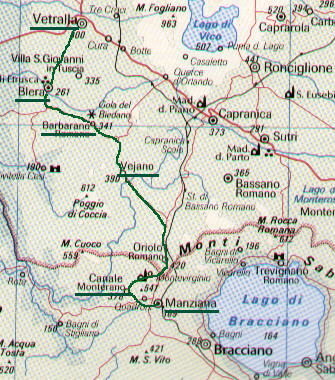 | ||
Manziana
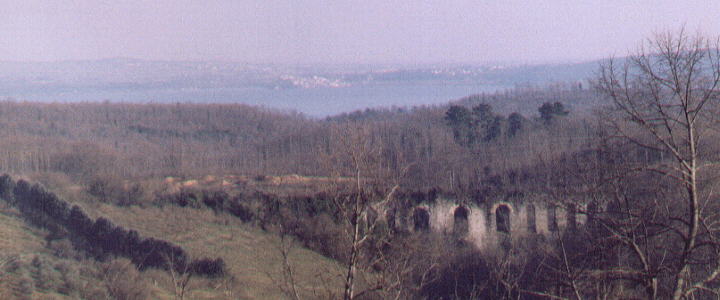 | ||
Manziana, maybe named after the manzi (steers) which were raised in the area, was a fiefdom of the di Vico family who ruled this region for many centuries and during the absence of the popes from Rome in the XIVth century made an attempt to establish a sovereign state in northern Latium . The return to Rome of the popes from Avignon put an end to the expansion of the di Vico. Eventually an attempt by the di Vico to undermine the authority of Pope Eugenius IV ended in defeat. In 1435 the last of the di Vico was beheaded in Soriano.
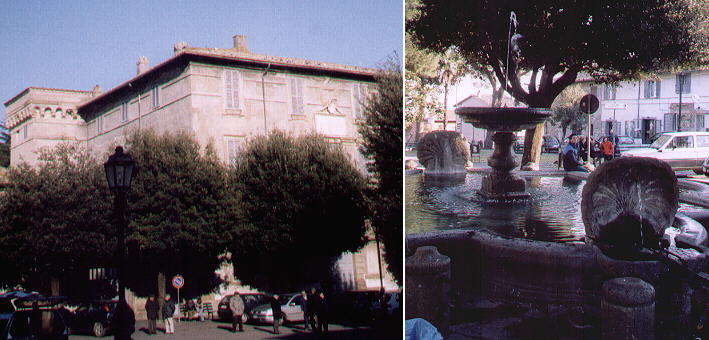 | ||
Manziana became a possession of Ospedale di S. Spirito and Manziana owes to a Cardinal in charge of the hospital its nice 1732 fountain and the reshaping of the fortifications built by the di Vico into a residential palace, now named after Tommaso Tittoni (1855-1931), a politician who set his residence in Manziana.
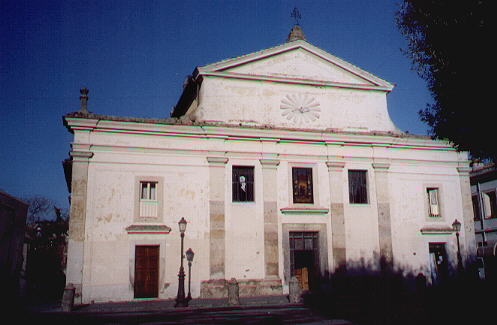 | ||
The cardinal (Pietro de Carolis) completed his improvement of the main square of Manziana by building a relatively large church.
Canale Monterano
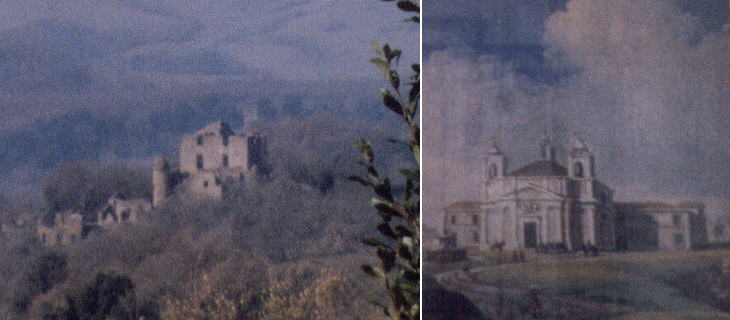 | ||
On December 20, 1669 65 cardinals met to elect the successor of Pope Clemens IX. 61 cardinals were Italians, but they had to take into account the pressures of France and Spain. The most obvious candidates were vetoed by one or the other great power. Four months later the cardinals were still in conclave and the delay embarrassed most cardinals who eventually decided to elect Cardinal Emilio Altieri, assuming that his age (80) would have made him accepted as an interim solution by both the French and the Spanish ambassadors, who on behalf of their lords tried to influence the outcome of the conclave. The interim solution lasted longer than expected; Pope Clemens X, as Cardinal Altieri chose to be called, ruled the church for more than 6 years.
His (adopted) nephew Cardinal Paluzzi-Altieri was appointed Secretary of State to run the administration of the papal state. Maybe because he feared he would have covered this role for a very short time, he devoted all his efforts to benefit as much as possible from it. When eventually Clemens X passed away, Cardinal Paluzzi-Altieri had ensured the wealthiness of the family for the forthcoming centuries. The Paluzzi-Altieri acquired several fiefdoms between Bracciano and Viterbo, the most notable being Oriolo, where they built a large palace. In Monterano the palaces and churches they built are today just ruins.
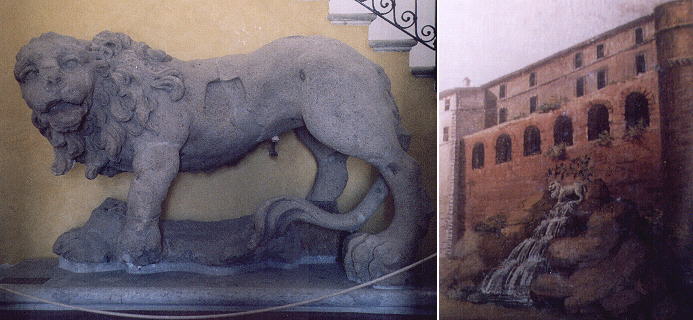 | ||
Monterano was located between the hills surrounding the lake of Bracciano and the hills of Tolfa on the coastline. This position required a continuous attention to ensuring rainfall waters found their way towards either the sea or the lake. But the economic policy followed by the popes did not promote farming: the popes bought large quantities of wheat and oil abroad and sold them at very low price to the many religious institutions that cared for the poor. This depressed the price of agricultural yields and in turn led to the abandonment of most of the land near Rome. This occurred also in Monterano and without the continuous work of the farmers, the area became marshy and unhealthy: Monterano was almost a ghost town when in 1799 the French set fire to it.
For their newly acquired fiefdom the Altieri sought the advice of Gian Lorenzo Bernini, who supervised the work of one of his pupils, Mattia de' Rossi. Monterano had a baronial palace, a cathedral, a large monastery and a monumental fountain.
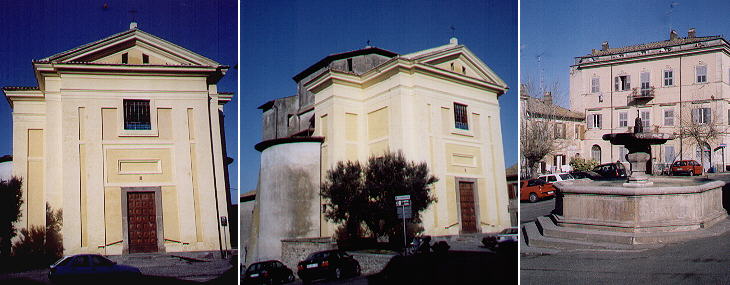 | ||
The hamlet of Canale, located on higher ground, some three miles east of Monterano, retains a church designed by Mattia de'Rossi and a fountain which once stood before a monastery of Monterano (as shown in the image used as background for this page). The statue of a lion, which once was at the top of a monumental fountain, can now be seen in the town hall of Canale together with paintings showing the monuments of the old town.
Veiano
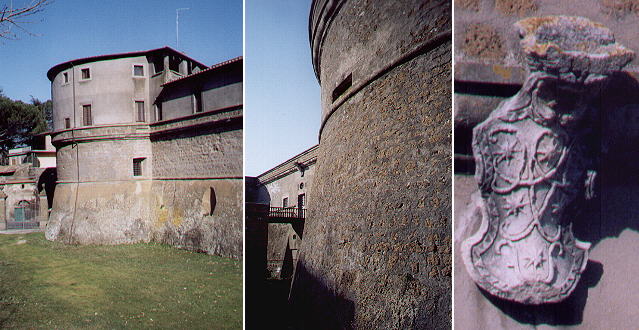 | ||
Santacroce and Altieri are the families who are associated with the fortress of Vejano and the small burg it protected. It is a "modern" fortress in the sense that it was designed to withstand the effects of modern artillery. It was erected by Giorgo Santacroce who acquired the fiefdom of Vejano in 1493, but soon he came in conflict with the ruling pope, Alexander VI Borgia, who was trying to create a kingdom for his son Cesare. The fortress was seized by the papal troops and its towers were pulled down. But the fortunes of the Borgia did not last after the pope's sudden death in 1503. The fortress was rebuilt in 1518 by Giorgio Santacroce's son, Onofrio most likely following a design by Antonio da Sangallo il Giovane.
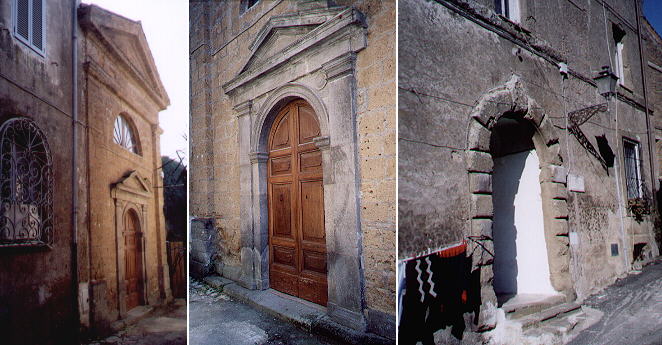 | ||
Antonio da Sangallo designed a chapel in the only street of the old burg, where some of the Santacroce were buried.
Move on to Barbarano, Blera and Vetralla.
some other walks:
Walks with Ferdinand Gregorovius in the Roman countryside
In and about Viterbo
From Civitavecchia to Civita Castellana
Around Monte Cimino
A Pigrims' Way - Via Francigena
On the Edge of the Marsh
In Maremma
Anticoli Corrado where the painters found their models
A walk to Porta Furba
Via Appia Antica from Cecilia Metella to Torre in Selci
Via Appia Antica from Torre in Selci to Frattocchie
A Walk to Ponte di Nona
Branching off Via Cassia: S. Maria di Galeria, Isola Farnese and Formello
A Walk to Malborghetto
See my Home Page on Baroque Rome or my Home Page on Rome in the footsteps of an XVIIIth century traveller
All images © 1999 - 2005 by Roberto Piperno. Write to romapip@quipo.it
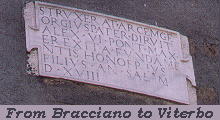 Manziana, Canale Monterano and Vejano
Manziana, Canale Monterano and Vejano